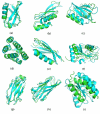Ab initio modeling of small proteins by iterative TASSER simulations
- PMID: 17488521
- PMCID: PMC1878469
- DOI: 10.1186/1741-7007-5-17
Ab initio modeling of small proteins by iterative TASSER simulations
Abstract
Background: Predicting 3-dimensional protein structures from amino-acid sequences is an important unsolved problem in computational structural biology. The problem becomes relatively easier if close homologous proteins have been solved, as high-resolution models can be built by aligning target sequences to the solved homologous structures. However, for sequences without similar folds in the Protein Data Bank (PDB) library, the models have to be predicted from scratch. Progress in the ab initio structure modeling is slow. The aim of this study was to extend the TASSER (threading/assembly/refinement) method for the ab initio modeling and examine systemically its ability to fold small single-domain proteins.
Results: We developed I-TASSER by iteratively implementing the TASSER method, which is used in the folding test of three benchmarks of small proteins. First, data on 16 small proteins (< 90 residues) were used to generate I-TASSER models, which had an average Calpha-root mean square deviation (RMSD) of 3.8A, with 6 of them having a Calpha-RMSD < 2.5A. The overall result was comparable with the all-atomic ROSETTA simulation, but the central processing unit (CPU) time by I-TASSER was much shorter (150 CPU days vs. 5 CPU hours). Second, data on 20 small proteins (< 120 residues) were used. I-TASSER folded four of them with a Calpha-RMSD < 2.5A. The average Calpha-RMSD of the I-TASSER models was 3.9A, whereas it was 5.9A using TOUCHSTONE-II software. Finally, 20 non-homologous small proteins (< 120 residues) were taken from the PDB library. An average Calpha-RMSD of 3.9A was obtained for the third benchmark, with seven cases having a Calpha-RMSD < 2.5A.
Conclusion: Our simulation results show that I-TASSER can consistently predict the correct folds and sometimes high-resolution models for small single-domain proteins. Compared with other ab initio modeling methods such as ROSETTA and TOUCHSTONE II, the average performance of I-TASSER is either much better or is similar within a lower computational time. These data, together with the significant performance of automated I-TASSER server (the Zhang-Server) in the 'free modeling' section of the recent Critical Assessment of Structure Prediction (CASP)7 experiment, demonstrate new progresses in automated ab initio model generation. The I-TASSER server is freely available for academic users http://zhang.bioinformatics.ku.edu/I-TASSER.
Figures



Similar articles
-
Analysis of TASSER-based CASP7 protein structure prediction results.Proteins. 2007;69 Suppl 8:90-7. doi: 10.1002/prot.21649. Proteins. 2007. PMID: 17705276
-
Integration of QUARK and I-TASSER for Ab Initio Protein Structure Prediction in CASP11.Proteins. 2016 Sep;84 Suppl 1(Suppl 1):76-86. doi: 10.1002/prot.24930. Epub 2015 Sep 23. Proteins. 2016. PMID: 26370505 Free PMC article.
-
I-TASSER server for protein 3D structure prediction.BMC Bioinformatics. 2008 Jan 23;9:40. doi: 10.1186/1471-2105-9-40. BMC Bioinformatics. 2008. PMID: 18215316 Free PMC article.
-
I-TASSER-MTD: a deep-learning-based platform for multi-domain protein structure and function prediction.Nat Protoc. 2022 Oct;17(10):2326-2353. doi: 10.1038/s41596-022-00728-0. Epub 2022 Aug 5. Nat Protoc. 2022. PMID: 35931779 Review.
-
AI-Driven Deep Learning Techniques in Protein Structure Prediction.Int J Mol Sci. 2024 Aug 1;25(15):8426. doi: 10.3390/ijms25158426. Int J Mol Sci. 2024. PMID: 39125995 Free PMC article. Review.
Cited by
-
ClusCo: clustering and comparison of protein models.BMC Bioinformatics. 2013 Feb 22;14:62. doi: 10.1186/1471-2105-14-62. BMC Bioinformatics. 2013. PMID: 23433004 Free PMC article.
-
Leishmania donovani pteridine reductase 1: comparative protein modeling and protein-ligand interaction studies of the leishmanicidal constituents isolated from the fruits of Piper longum.J Mol Model. 2012 Dec;18(12):5065-73. doi: 10.1007/s00894-012-1508-y. Epub 2012 Jul 3. J Mol Model. 2012. PMID: 22752544
-
Insights into the mutation-induced HHH syndrome from modeling human mitochondrial ornithine transporter-1.PLoS One. 2012;7(1):e31048. doi: 10.1371/journal.pone.0031048. Epub 2012 Jan 26. PLoS One. 2012. PMID: 22292090 Free PMC article.
-
Protein structure prediction.Int J Mod Phys B. 2018 Jul 20;32(18):1840009. doi: 10.1142/S021797921840009X. Epub 2017 Dec 11. Int J Mod Phys B. 2018. PMID: 30853739 Free PMC article.
-
Mutation in TACO1, encoding a translational activator of COX I, results in cytochrome c oxidase deficiency and late-onset Leigh syndrome.Nat Genet. 2009 Jul;41(7):833-7. doi: 10.1038/ng.390. Epub 2009 Jun 7. Nat Genet. 2009. PMID: 19503089
References
Publication types
MeSH terms
Substances
LinkOut - more resources
Full Text Sources

